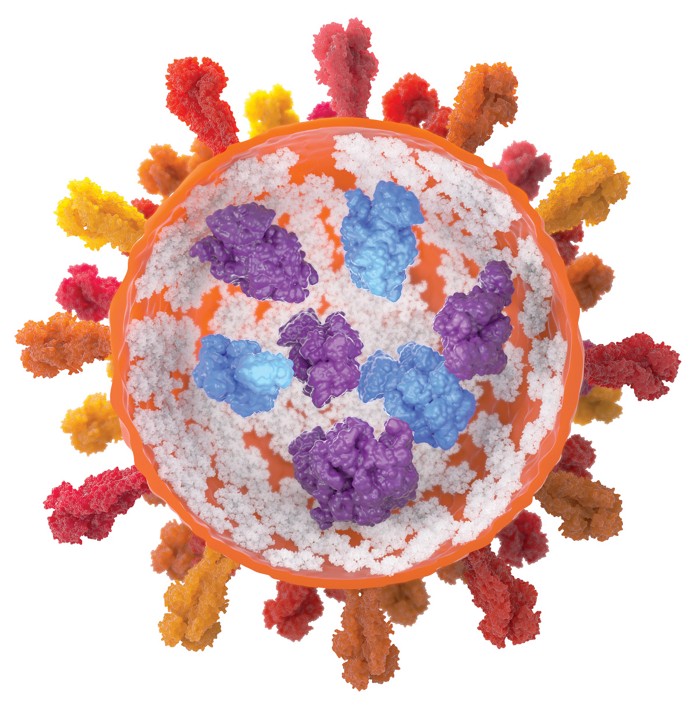Advertisement
Grab your lab coat. Let's get started
Welcome!
Welcome!
Create an account below to get 6 C&EN articles per month, receive newsletters and more - all free.
It seems this is your first time logging in online. Please enter the following information to continue.
As an ACS member you automatically get access to this site. All we need is few more details to create your reading experience.
Not you? Sign in with a different account.
Not you? Sign in with a different account.
ERROR 1
ERROR 1
ERROR 2
ERROR 2
ERROR 2
ERROR 2
ERROR 2
Password and Confirm password must match.
If you have an ACS member number, please enter it here so we can link this account to your membership. (optional)
ERROR 2
ACS values your privacy. By submitting your information, you are gaining access to C&EN and subscribing to our weekly newsletter. We use the information you provide to make your reading experience better, and we will never sell your data to third party members.
Drug Delivery
Therapeutic protein delivery could piggyback on engineered parasite
Scientists have reverse engineered a common brain parasite to deliver targeted protein therapies to mouse brains
by Payal Dhar, special to C&EN
August 1, 2024
| A version of this story appeared in
Volume 102, Issue 24

The blood–brain barrier, a selective, semipermeable border around the central nervous system, is the body’s built-in mechanism to protect these critical areas from unwanted intruders like toxins and parasites. But it can also keep out important molecules, like therapeutic proteins, that target this part of the body.
In a recent study, scientists demonstrated a mechanism that piggybacks on a single-cell parasite, Toxoplasma gondii, which naturally crosses the blood–brain barrier. Using engineered versions of this parasite, they were able to deliver a protein that’s used to treat a neurological disorder called Rett syndrome directly to nerve cells in the brains of mice (Nat. Microbiol. 2024, DOI: 10.1038/s41564-024-01750-6).
T. gondii is capable of infecting most warm-blooded animals, including humans, and is ubiquitous across the world. It usually enters animals by ingestion, and the parasite then migrates naturally to the central nervous system. It is responsible for causing toxoplasmosis, which infects the brain.
Sending drugs across the blood–brain barrier is something of a holy grail in neuroscience, and scientists have tried a variety of techniques but struggled to attain reasonable efficiencies. Shahar Bracha, a neuroscientist at the Massachusetts Institute of Technology and the first author of the study, says that T. Gondii has already developed complex mechanisms to pass through the barrier, enter nerve cells, and secrete proteins into them. “Engineering a synthetic system that can do [all this] would be very hard,” she says.
Bracha and colleagues edited the genes that control the parasite’s protein delivery mechanism. “We took a series of proteins that we knew had benefits either as tools in neuroscience or ones that could potentially be therapeutic, and fused them with proteins that the parasite already knows how to secrete,” she says.
The engineered parasite successfully delivered different proteins to the host cells in human brain organoids and also in mice. One of these proteins was MeCP2, used to treat Rett syndrome.
The study serves as a proof of concept, Bracha says, and therapeutic applications are aspirational. “What we present here is a very general platform technology, where you can imagine many different proteins can be delivered by the same vector,” she says.
The next step is to work on the attenuation of the vectors, that is, to make sure that apart from delivering the protein to the host cell, “they don’t do anything that we don’t want them to do,” Bracha says. Her colleagues from the University of Glasgow are currently working on this.
Bracha and some of her coauthors are also part of a start-up called Epeius Pharma, which plans to leverage the technology in the future.
Michail Kastellorizios, a pharmaceutical scientist who studies drug delivery mechanisms at the University of North Texas’s College of Pharmacy, says the study is an innovative and robust demonstration of a platform technology. In biotech terms, this refers to a system upon which other processes and applications can be built.
Such technologies, Kastellorizios says, allow scientist to learn about systems that occur in nature and can be harnessed for therapeutic purposes. As the approach enters preclinical testing stages, though, he adds, one of the challenges will be to show an acceptable level of purity or efficiency of drug delivery.




Join the conversation
Contact the reporter
Submit a Letter to the Editor for publication
Engage with us on Twitter